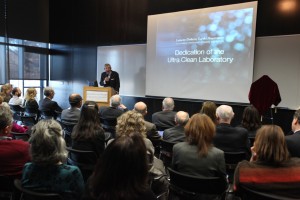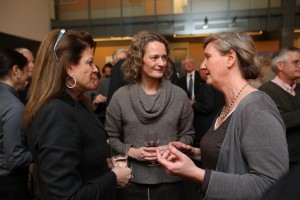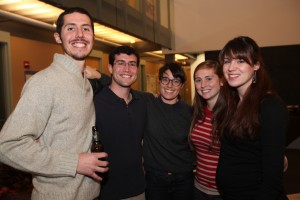Development
A mix of government funding agencies, private foundations and donors support Lamont’s research and education initiatives; the extraordinary generosity of our friends, alumni and staff continues to be deeply appreciated by all of us at the Observatory. Every gift, large or small, helps generate another discovery. And in that way, every donor becomes a partner in our scientific and educational endeavors and plays a key role in advancing the fundamental knowledge needed to sustain our planet
We are deeply appreciative of the consistent and significant support we receive from the G. Unger Vetlesen Foundation. Their decades of support have enabled the Observatory to recruit and retain key members of our research staff who pioneer climate research and increase understanding of vital Earth and atmospheric processes.
Our gratitude to the Gordon and Betty Moore Foundation, which awarded Lamont $1,100,000 for a research project focused on remote sensing of sea ice, surface ocean and atmospheric parameters. The project, led by Chris Zappa, will use a high-endurance unmanned aircraft system (UAS) to gather data on climate changes in the Arctic Ocean around Svalbard, Norway. The use of a UAS enables observations in ways not possible by traditional manned aircraft or satellites.
We are also grateful for support from the Deep Carbon Observatory, a program of the Alfred P. Sloan Foundation, which provided $650,000 in funding to support field studies in Oman led by Lamont geologist Peter Kelemen. The Oman site represents Earth’s largest sample of exposed oceanic lithosphere, igneous crust and upper mantle that originally formed at a submarine spreading center. Drilling into these rocks may provide important insight into the origins of life on Earth.
We also extend our gratitude to the Pinkerton Foundation for supporting the Secondary School Field Research Program, which provides a hands-on research experience for high school students and teachers from New York City.
Thanks to the generosity of our alumni, friends and staff, the Observatory met a fundraising challenge made by the Lenfest Foundation to match up to $250,000 in donations for the creation of a conference room in the Gary C. Comer Geochemistry Building. The room, named for climate scientist Wally Broecker, will benefit future generations of young researchers who, inspired by extraordinary scientists like Wally, will answer key questions in Earth science.
We are deeply appreciative of a gift from alumnus John Armbruster, who contributed $254,332 in support of the restoration of Lamont Hall, which helped initiate the Lamont Hall Restoration Fund. A new committee is exploring the potential uses of the building.
New Geochemistry Facility Dedicated
At the heart of any research endeavor is the quality and capacity of the facility that supports data generation and facilitates scientific understanding. With this in mind, in June 2004, Gary C. Comer, founder of Lands’ End and friend of Lamont geochemist Wallace Broecker, offered to help construct what is now known as the Gary C. Comer Geochemistry Building. In late 2013, Comer’s dream of creating a uniquely powerful facility for the Lamont Geochemistry Division became a reality upon completion of the Comer Building’s Ultra Clean Laboratory.
On the afternoon of November 20, 2013, the Ultra Clean Laboratory was dedicated in front of an audience of Observatory Advisory Board members, donors, scientists and other members of the extended Lamont and Columbia University communities.
“No other science discipline can boast the leadership in the geochemical field that belongs at Lamont,” said Michael Purdy, Columbia University’s Executive Vice President for Research and former director of Lamont, in remarks during the dedication.
- Michael Purdy makes remarks during the Ultra Clean Lab dedication.
- Advisory Board Chair Sarah E. Johnson with scientists Bärbel Hönisch and Terry Plank.
- Lamont geochemistry graduate students and users of the Ultra Clean Lab.
In addition to the support from Gary C. Comer, construction of the Comer Building and Ultra Clean Laboratory was made possible by a grant from the National Institute for Science and Technology (NIST) through the American Recovery and Reinvestment Act of 2009, in response to a proposal submitted by Observatory scientists requesting funding for a state-of-the-art facility. Members of Lamont’s Advisory Board and many private donors also enabled completion of the lab.
Advisory Board
The Lamont Advisory Board is comprised of 17 community leaders, donors, loyal friends and alumni who deeply believe in our mission to generate fundamental knowledge about the origin, evolution and future of the natural world. The Board provides advice and support to the Observatory, meeting four times per year and participating in committees focused on education, Board membership, marketing and communications, risk and fundraising. Sarah E. Johnson, a film producer and philanthropist, became chair of the Advisory Board in 2014.
Alumni Board
Lamont’s Alumni Board, led by Greg Mountain ‘81, is made up of former graduate students, researchers and staff who strive to promote the welfare of Lamont by acting as advocates and supporters of the Observatory’s mission. Members play an important role in fostering communication and interaction among Lamont alumni.
This past year the Alumni Board initiated a distinguished lecture series. Each lecture, given by an alumnus invited to visit colleagues and students on campus, provides Lamont the opportunity to honor one of its own and renew connections among our scientists and past and present students. The inaugural lecturer, Peter Molnar ’70, Professor of Geological Sciences at the University of Colorado, Boulder, and the recipient of the 2014 Crafoord Prize, had a successful and engaging visit in April 2014. The board plans to continue the series on an annual basis.
We encourage alumni to connect with us and experience the value of maintaining ties across miles and years, whether at our annual Alumni Reception in San Francisco each December, on campus, or whenever you’re in Greater New York.


